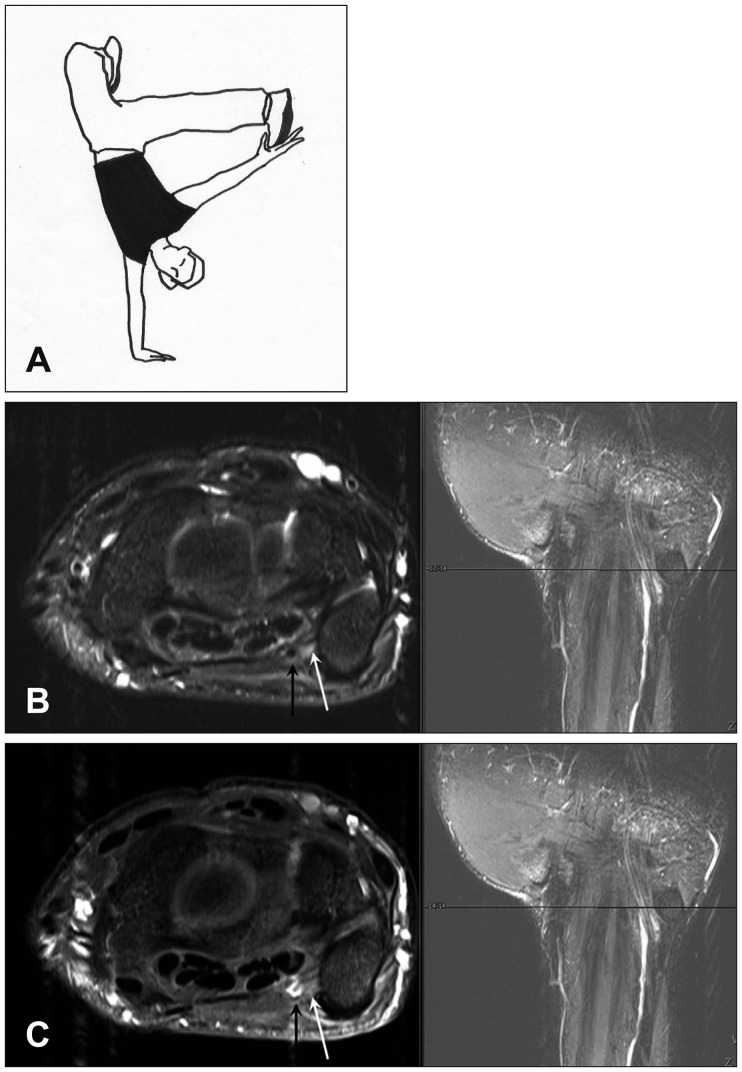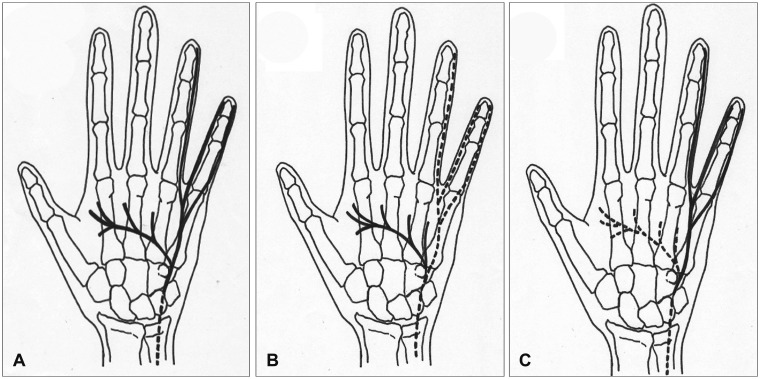Korean J Neurotrauma.
2015 Oct;11(2):183-186. 10.13004/kjnt.2015.11.2.183.
Type III Guyon Syndrome in 'B Boy' Break-Dancer: A Case Report
- Affiliations
-
- 1Department of Neurosurgery, Seoul St. Mary's Hospital, College of Medicine, The Catholic University of Korea, Seoul, Korea. sbc@catholic.ac.kr
- 2The Catholic Neuroscience Institute, College of Medicine, The Catholic University of Korea, Seoul, Korea.
- KMID: 2378284
- DOI: http://doi.org/10.13004/kjnt.2015.11.2.183
Abstract
- Although the musculoskeletal injuries associated with break-dancing which is gaining more popularity among adolescent and young people has been reported, the report regarding a peripheral nerve injury associated with breakdance is scarce. We report a rare case of a young amateur break-dancer, 'b-boy' who suffered from a painful paresthesia in his left hand, later diagnosed as type III Guyon's canal syndrome. A 23-year-old, right handed college man presented with a tenderness over the left hypothenar eminence and painful paresthesia over the ring and little fingers of 3 months duration. He trained himself as an amateur 'b boy' break-dancer for the last 10 months. Conservative management under the diagnosis of wrist sprain before presentation did not improve his hand pain. An magnetic resonance imaging and electrodiagnostic study revealed that painful paresthesia was caused by type III Guyon's canal syndrome, and 4 weeks of corticosteroid treatment was given with resolution of pain and paresthesia.
MeSH Terms
Figure
Reference
-
1. Cho CH, Song KS, Min BW, Lee SM, Chang HW, Eum DS. Musculoskeletal injuries in break-dancers. Injury. 2009; 40:1207–1211. PMID: 19540489.
Article2. Cho YJ, Cho SM, Sheen SH, Heo DH, Cho JH, Oh SM. Minimally invasive ulnar nerve decompression for cubital tunnel syndrome. J Korean Neurotraumatol Soc. 2009; 5:16–21.
Article3. Duggal A, Anastakis DJ, Salonen D, Becker E. Compression of the deep palmar branch of the ulnar nerve by a ganglion: a case report. Hand (N Y). 2006; 1:98–101. PMID: 18780033.4. Kauther MD, Wedemeyer C, Wegner A, Kauther KM, von Knoch M. Breakdance injuries and overuse syndromes in amateurs and professionals. Am J Sports Med. 2009; 37:797–802. PMID: 19204362.
Article5. Maroukis BL, Ogawa T, Rehim SA, Chung KC. Guyon canal: the evolution of clinical anatomy. J Hand Surg Am. 2015; 40:560–565. PMID: 25446410.
Article6. Norman RA, Grodin MA. Injuries from break dancing. Am Fam Physician. 1984; 30:109–112. PMID: 6238511.7. Pecina MM, Krmpotic-Nemanie J, Markiewitz AD. Tunnel syndromes: peripheral nerve compression syndromes, ed 3. Boca Raton, FL: CRC Press;2001.8. Toledo SD, Akuthota V, Drake DF, Nadler SF, Chou LH. Sports and performing arts medicine. 6. Issues relating to dancers. Arch Phys Med Rehabil. 2004; 85(3 Suppl 1):S75–S78. PMID: 15034860.
- Full Text Links
- Actions
-
Cited
- CITED
-
- Close
- Share
- Similar articles
-
- Compression Neuropathy of the Ulnar Nerve due to the Accessory Abductor Digiti Minimi at Guyon’s Canal: A Case Report
- Ulnar Neuropathy Caused by a Schwannoma in the Guyon's Cannal
- Guyon’s Canal Syndrome Caused by an Accessory Abductor Digiti Minimi Muscle
- Identification of Double Compression Lesion of Ulnar Nerve after Cubital Tunnel Release
- Posterior Impingement Syndrome of the Ankle Joint in Classical Ballet Dancer



